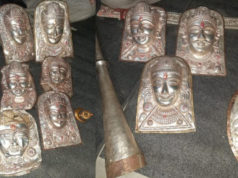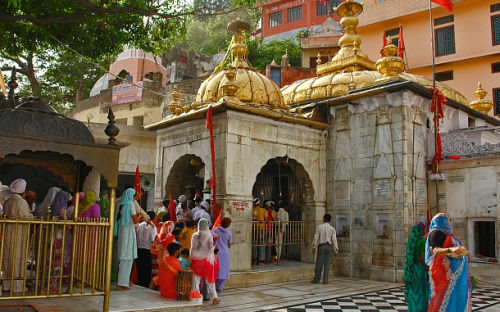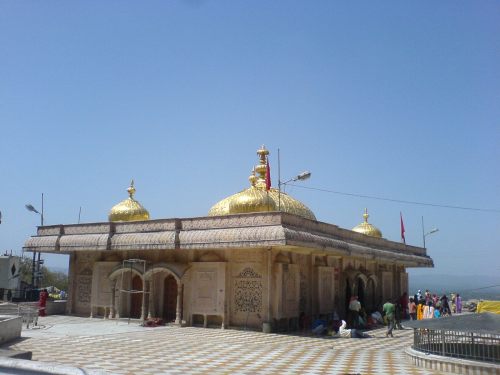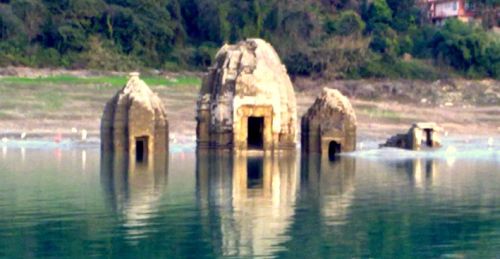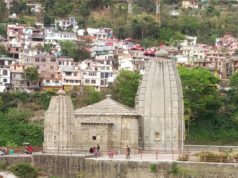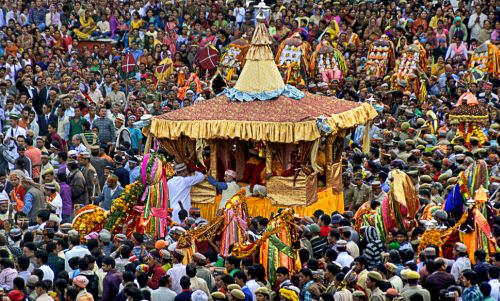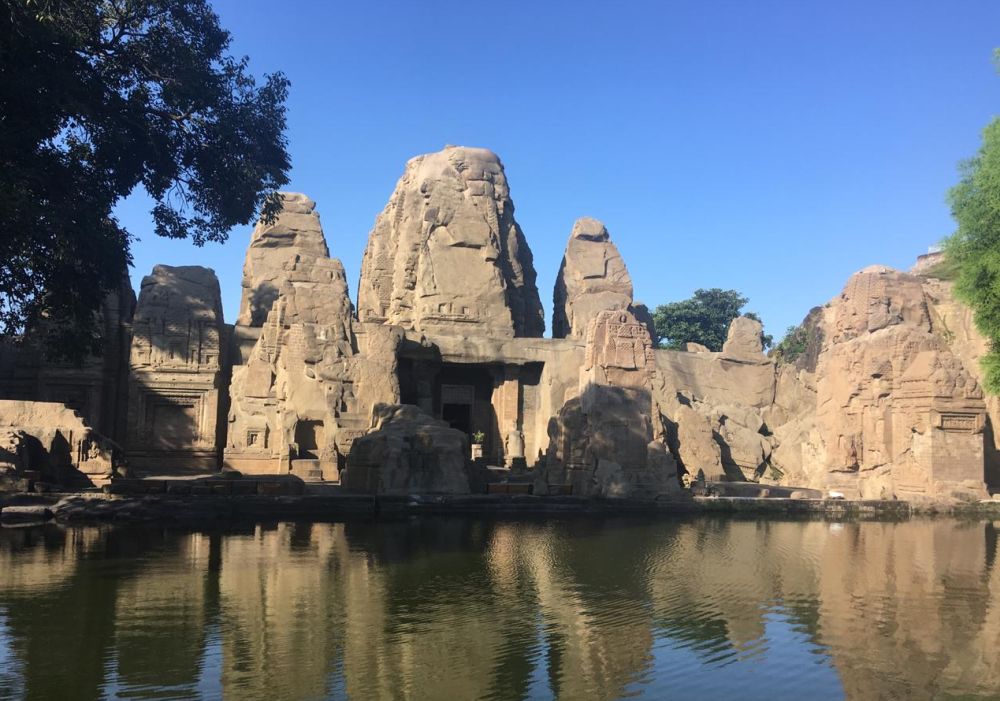
Nestled amidst the mystical landscapes of Himachal Pradesh, Kangra District beckons the seeker, the pilgrim, and the curious traveller to embark on a spiritual odyssey. Here, where the snow-capped Dhauladhar Range meets verdant valleys, the air resonates with ancient hymns, and each stone seems to whisper tales of devotion. In this sacred land, we unveil a tapestry woven with threads of faith, history, and divine energy — Kangra’s array of fifteen temples, each a sanctum with its legend, each a spiritual portal to a realm beyond the ordinary.
Our journey commences at the Jwalamukhi Mata Temple, where an eternal flame signifies the goddess’s enduring presence. As we ascend Nagarkot Hill, the Nagarkot Mata Temple reveals itself as an abode of serenity, echoing the divine vision of Goddess Sati. Baijnath Temple, a timeless architectural marvel, invites us to explore the artistic brilliance of medieval India, while the Chamunda Devi Temple, against the formidable Dhauladhar Range, exudes an aura of strength and spiritual resilience.
As we traverse through the historical Kangra Fort, housing the Brajeshwari Devi Temple, and witness the mystical flames of Jawalamukhi, our spiritual sojourn unfolds. From the tranquil haven of Chintpurni to the rock-cut marvel of Masroor, each temple on this divine pilgrimage paints a vivid chapter in the canvas of Kangra’s religious heritage.
Join us as we unveil each temple’s legends, architecture, and sacred aura, traversing a landscape where spirituality intertwines with the grandeur of nature. Kangra’s temples, standing as silent sentinels of devotion, invite you to immerse yourself in a journey that transcends time, forging a connection with the divine that echoes through the ages.
1. Jwalamukhi Mata Temple: The Sacred Abode of the Eternal Flame
Nestled in the serene hills of Kangra, the Jwalamukhi Mata Temple is a sacred sanctuary that resonates with a divine energy that transcends time. This temple, often referred to as Jwala Mata Temple, is renowned for the eternal flame that has burned unwaveringly for centuries. According to mythology, it is believed that the tongue of Goddess Sati, a manifestation of her fiery energy, fell at this very spot during the cosmic dance of Lord Shiva.
Pilgrims from far and wide are drawn to the mystical allure of Jwalamukhi Mata Temple. The perpetually burning flames are manifestations of the goddess’s divine power, symbolizing her everlasting presence. Devotees flock to this sacred abode seeking courage, strength, and the blessings of the goddess to illuminate their spiritual journey.
The temple complex is an architectural marvel, with its sacred flame housed in a sanctum surrounded by a gold-plated dome. Pilgrims engage in rituals and prayers, enveloped in the spiritual ambience created by the perpetual flames. Jwalamukhi Mata Temple is not merely a place of worship; it’s a testament to the enduring power of faith and the eternal connection between the divine and the devoted.
2. Nagarkot Mata Temple: The Abode of Serenity
Nagarkot Mata Temple, perched atop the majestic Nagarkot Hill, is not just a sacred sanctuary but a testament to the divine grace associated with Goddess Sati. Legend has it that the temple marks the spot where the goddess’s eyes fell during Lord Shiva’s cosmic dance. Pilgrims ascend the hill seeking not only spiritual solace but also the divine vision believed to be bestowed upon those who stand in the sanctum. The temple’s serene surroundings, coupled with the panoramic views of the Kangra Valley, create an atmosphere of tranquillity, making it a sought-after destination for introspection and communion with the divine.
3. Baijnath Temple: A Timeless Architectural Marvel
Baijnath Temple, dedicated to Lord Shiva, stands as a timeless architectural marvel amid the verdant landscapes of Kangra. Legend has it that the demon king Ravana, an ardent devotee of Shiva, constructed this temple to seek the deity’s blessings. The intricately carved stone structures narrate tales of devotion and artistic brilliance, transporting visitors to an era where spirituality and craftsmanship converged seamlessly. Pilgrims and history enthusiasts alike flock to Baijnath to witness the fusion of divine sanctity and architectural grandeur, each stone echoing the hymns of devotion and the tales of a bygone era.
4. Chamunda Devi Temple: The Forceful Divine Presence
Nestled against the formidable Dhauladhar Range, the Chamunda Devi Temple exudes a potent aura of strength and divinity. Legend narrates that Goddess Chamunda annihilated the demons Chand and Mund at this very site. Pilgrims are drawn to the temple seeking the goddess’s blessings for strength, protection, and the courage to overcome life’s adversities. The temple’s sacred ambience, set against the majestic backdrop of the mountains, creates an atmosphere where spirituality and nature harmonize, offering devotees a unique and powerful spiritual experience.
5. Brajeshwari Devi Temple: The Temple of Sati
Located within the historic Kangra Fort, the Brajeshwari Devi Temple holds a significant place in the religious and cultural tapestry of Kangra. It is believed to be the spot where the breast of Goddess Sati fell. The temple’s unique architectural style reflects the evolving history of the region, having been reconstructed multiple times due to invasions and natural calamities. Pilgrims visit Brajeshwari Devi seeking the goddess’s blessings for prosperity and well-being. The temple is a resilient symbol of faith, weathering centuries of change while remaining a beacon of divine energy and cultural heritage.
6. Chintpurni Temple: Seeking Liberation
Perched in the serene surroundings, the Chintpurni Temple is dedicated to Goddess Chinnamasta, symbolizing liberation from worries and anxieties. The goddess, depicted as self-decapitated, signifies detachment from material concerns. Pilgrims undertake a spiritual sojourn to Chintpurni, seeking mental peace and freedom from the cycles of birth and death. The temple’s tranquil ambience fosters an environment conducive to introspection and liberation from the burdens of the mind.
7. Masroor Rock Cut Temple: An Architectural Marvel
The Masroor Rock Cut Temple, often referred to as the ‘Himalayan Pyramid,’ stands as an exceptional example of rock-cut architecture. Believed to have been built in the 8th century, this archaeological gem showcases intricate carvings and sculptures. The temple complex unfolds stories of devotion and artistic brilliance, transporting visitors to a bygone era where spirituality and craftsmanship converged. Pilgrims and history enthusiasts visit Masroor to witness the unique blend of cultural heritage and architectural splendour etched in the stone.
8. Trilokpur Temple: The Cave Sanctuary
Hidden within caves, the Trilokpur Temple is dedicated to Lord Shiva. The natural surroundings add an air of mystique to the temple, creating an ambience that resonates with seekers of spiritual tranquillity. Devotees embark on a journey to Trilokpur to experience the divine presence in the cave sanctuary, where the echoes of prayers and the serenity of the surroundings converge in a harmonious union.
9. Baglamukhi Temple: The Goddess of Power
Enter the hallowed precincts of the Baglamukhi Temple, dedicated to the fierce goddess who symbolizes the power to dominate and control. The temple’s unique architecture and divine energy attract devotees seeking strength and protection. Baglamukhi is revered as the granter of victory, and pilgrims come to this sacred abode to overcome obstacles and emerge triumphant in their endeavours.
10. Sheetla Mata Temple: A Divine Retreat
Tucked amidst lush greenery, the Sheetla Mata Temple offers a serene retreat for the soul-weary. Devotees visit this temple to seek the blessings of the goddess and find solace in the tranquil surroundings. Sheetla Mata is revered as the goddess of healing and protection, making this temple a haven for those seeking physical and spiritual well-being. The gentle rustling of leaves and the fragrance of nature enhance the divine ambiance, providing a perfect sanctuary for seekers of peace.
11. Bhagsunath Temple: Serenity Amidst Nature
In the quaint village of Bhagsu, the Bhagsunath Temple dedicated to Lord Shiva offers serenity amidst nature’s beauty. Surrounded by lush landscapes, this temple becomes a spiritual oasis where devotees connect with the divine in a tranquil setting. The nearby waterfall’s soothing sound adds to the sacred ambience, creating a perfect blend of spirituality and the refreshing essence of the natural world.
12. Mahakal Temple: A Spiritual Oasis
The Mahakal Temple, dedicated to Lord Shiva, invites pilgrims to experience a spiritual oasis. The temple’s serene surroundings and spiritual energy make it a haven for those seeking inner peace and connection with the divine. Devotees immerse themselves in prayers and rituals, resonating with the powerful presence of Lord Shiva. The breathtaking views of the surrounding mountains add to the spiritual journey, making Mahakal Temple a destination for both tranquillity and reverence.
13. Brajeshwari Devi Temple in Kangra Fort: Historical Splendor
Explore the historical Kangra Fort, where the Brajeshwari Devi Temple unfolds its historical and religious splendour. Dedicated to Goddess Sati, this temple has witnessed centuries of cultural evolution and has been reconstructed multiple times due to invasions. Pilgrims and history enthusiasts alike visit the temple within the fort’s walls to seek the goddess’s blessings and to marvel at the historical grandeur that stands as a testament to the region’s rich heritage.
14. Sui Mata Temple: A Tribute to Maternal Love
Our spiritual odyssey concludes at the Sui Mata Temple, a tribute to maternal love and sacrifice. Set amidst lush gardens, this temple is dedicated to Queen Sui, who sacrificed her life to save her son. Devotees visit to honour the spirit of maternal love and seek blessings for the well-being of their families. The temple’s peaceful surroundings and poignant legend create an atmosphere of reverence and gratitude.
A Tapestry of Tranquility and Devotion Unveiled
As we conclude this sacred journey through Kangra’s 14 divine temples, we find ourselves immersed in a tapestry woven with threads of tranquillity, devotion, and cultural richness. Each temple, with its unique legend and architectural splendour, adds a vibrant hue to the spiritual canvas of Kangra. From the eternal flames at Jwalamukhi Mata Temple to the historical echoes within Kangra Fort’s Brajeshwari Devi Temple, this pilgrimage has been a testament to the enduring faith that has withstood the test of time.
These temples, nestled amidst the breathtaking landscapes of Himachal Pradesh, invite us to transcend the ordinary and connect with the divine. Whether seeking solace in the serene surroundings of Nagarkot Mata Temple or marvelling at the architectural brilliance of Masroor Rock Cut Temple, Kangra unfolds a spiritual journey that transcends geographical boundaries and resonates with the universal pursuit of inner peace.
As we bid farewell to this spiritual sojourn, may the echoes of prayers, the scent of incense, and the timeless stories etched in stone linger in our hearts. Kangra, with its diverse temples, not only reveals religious fervour but also serves as a sanctuary where the soul finds repose. Until our next pilgrimage, may the divine energy experienced in these sacred precincts continue to illuminate our paths, fostering a lasting connection between the earthly and the divine.



